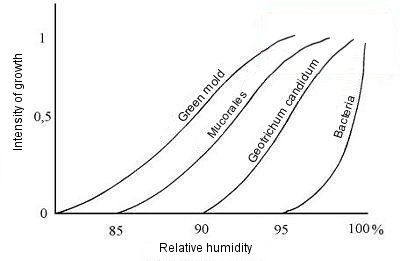The nutrients are absorbed by the microorganisms after having been dissolved by means of enzymes. Molds are divided into three groups (see Fig. 78):

Figure 78:
Intensity of microbial growth as a function of relative humidity;
Hermann [17]
- Types surviving at low relative humidities of approx. 75% (xerophilic), such as green mold
- Types thriving at relative humidities of over 86% (mesophilic), such as Mucorales fungi
- Types requiring a relative humidity of over 90% (hygrophilic), such as Geotrichum candidum.
- Bacteria are active above 95% relative humidity.
Overall, the mold growth threshold should be deemed to stand at 75% relative humidity, while bacteria only become active above 95%. This explains why fruit firstly suffers mold attack, with bacterial decomposition processes only starting at a higher relative humidity resulting, among other things, from the associated higher level of respiration.
|
